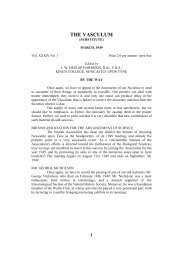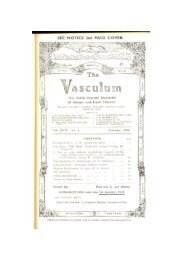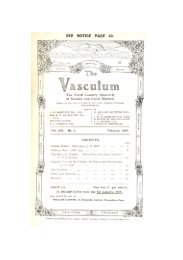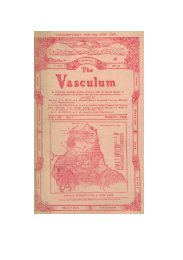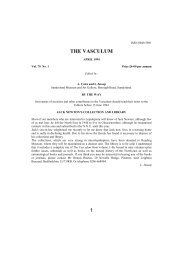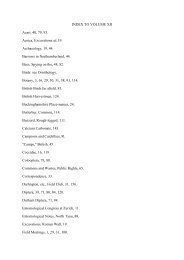1972 - The Vasculum
1972 - The Vasculum
1972 - The Vasculum
Create successful ePaper yourself
Turn your PDF publications into a flip-book with our unique Google optimized e-Paper software.
nature trail at present under construction. It should be mentioned that the dene is a<br />
reserve owned by the Durham County Conservation Trust. We thank the trust for<br />
their kind permission to visit the reserve on this occasion.<br />
<strong>The</strong> woodland flowers were at their best with huge white drifts of<br />
Ramsons, Allium ursinum L. Elsewhere we saw Wood Anemone, Wood Sanicle,<br />
Wood Sorrel, Dog's Mercury, Wood Sedge, Early Purple Orchid, Bugle, Grounud<br />
Ivy, Yellow Pimpernel etc. At one point along the trail a fully active badger's sett was<br />
examined. <strong>The</strong> entomologists beat the trees and bushes for larvae without much of a<br />
return. However, caterpillars of the Winter Moth, Common White Wave and Green<br />
Brindled Crescent were seen.<br />
Bird song was at its peak. <strong>The</strong> Summer visitors were well represented, the<br />
songs of the Chiffchaff, Willow Warbler, Whitethroat and Blackcap were recorded by<br />
Dr. Crosby and Mr. Gent. Resident species heard included blackbird, song thrush,<br />
robin, wren, great tit and chaffinch. Other birds noted were carrion crow, starling,<br />
greenfinch and redpoll.<br />
<strong>The</strong> 132nd Field Meeting was held at Holystone in Coquetdale on<br />
Saturday, 15th July, <strong>1972</strong>. Owing to the remoteness of the venue only six carloads of<br />
members and friends gathered at the car park in the Holystone Reserve, which is<br />
managed by the Northumberland Wildlife Trust. Again we have to thank the Trust for<br />
their kind permission. Dr. Clark led the party across relict woodland to examine the<br />
many interesting flushes that appeared along one contour of the hillside. We found a<br />
large number of sedges, some of them quite rare. <strong>The</strong>re were also a good variety of<br />
rushes, large numbers of the Moorland Spotted Orchid, Dactylorchis maculata (L.)<br />
Vermeul. ssp. ericetorum (E. F. Linton) Vermeul., Butterwort, Pinguicula vulgaris L.<br />
and Round-leaved Sundew, Drosera rotundifolia L.<br />
Insects were plentiful. Flying in the heather were the Small Heath<br />
Butterfly, Coenonympha pamphilus L. and Small Copper, Lycaena phlaeas L. A few<br />
moths were also seen, the most notable being the Smoky Wave, Scopula temata<br />
Schrank. and the Scarce Silver Y, Plusia interrogationis L. <strong>The</strong> Wood Ant, Formica<br />
rufa L. was in huge quantity with large mound nests in the forest areas and slightly<br />
smaller ones in the heathy parts. <strong>The</strong> Click Beetles were flying freely in the unusual<br />
high temperatures as was also the Tiger Beetle.<br />
Of the birds, Mr. Gent noted the Curlew, Blue Tit, Long-tailed Tit, Wren,<br />
Grasshopper Warbler, Whitethroat, Willow Warbler, Dunnock, Meadow Pipit,<br />
Redpoll and Chaffinch.<br />
12



